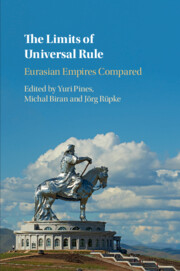Book contents
- The Limits of Universal Rule
- The Limits of Universal Rule
- Copyright page
- Contents
- Maps
- Figures
- Contributors
- Abbreviations
- Preface
- Introduction
- 1 From the Mediterranean to the Indus Valley: Modalities and Limitations of the Achaemenid Imperial Space
- 2 Limits of All-Under-Heaven: Ideology and Praxis of “Great Unity” in Early Chinese Empire
- 3 The Roman Empire
- 4 The Medieval Roman Empire of the East as a Spatial Phenomenon (300–1204 CE)
- 5 Early Islamic Imperial Space
- 6 The Mongol Imperial Space
- 7 The Territories and Boundaries of Empires
- 8 Delimiting the Realm Under the Ming Dynasty
- 9 The Expansion of the Qing Empire Before 1800
- 10 All Under the Tsar
- Index
- References
10 - All Under the Tsar
Russia’s Eurasian Trajectory
Published online by Cambridge University Press: 07 January 2021
- The Limits of Universal Rule
- The Limits of Universal Rule
- Copyright page
- Contents
- Maps
- Figures
- Contributors
- Abbreviations
- Preface
- Introduction
- 1 From the Mediterranean to the Indus Valley: Modalities and Limitations of the Achaemenid Imperial Space
- 2 Limits of All-Under-Heaven: Ideology and Praxis of “Great Unity” in Early Chinese Empire
- 3 The Roman Empire
- 4 The Medieval Roman Empire of the East as a Spatial Phenomenon (300–1204 CE)
- 5 Early Islamic Imperial Space
- 6 The Mongol Imperial Space
- 7 The Territories and Boundaries of Empires
- 8 Delimiting the Realm Under the Ming Dynasty
- 9 The Expansion of the Qing Empire Before 1800
- 10 All Under the Tsar
- Index
- References
Summary
This article considers the significance of geopolitical space to the configuration of the Russian Empire. The spatial possibilities for empire depend in part on what other empires have set in place or ignored. Moscow emerged as a bud of imperial power because at the start no great power was interested in its backwater location. Ambitious princes in this region had a chance to expand and learn how to govern before other powers took notice. Moscow’s leaders also had the good geographical fortune of eventually rubbing up against multiple imperial powers during their history. Their dynasty, the Rus’, had integrated Viking and Eurasian-style political practices on the way to power in Kiev. Kiev bequeathed Muscovites a distinctly imperial state religion – Byzantine-style Christianity with its linguistic tolerance, writing systems, and resplendent art. When the Mongols extended their western empire into the lands of the Rus’, the Muscovites acquired useful administrative techniques and were compelled into expansion to retain their hold as first-rank subordinates of the Chinggisid khans. The subsequent Romanov dynasty and the later communist and post-communist leaders continued the practices of expansion in Eurasian space and inclusion of unlike peoples under imperial protection and discipline. Russia’s rulers kept acquiring military, economic, and cultural skills from a series of imperial competitors – the Ottomans, Habsburgs, Prussians, British and the rest of what became known as the West – over the next centuries and into the present. At the start, distance from great powers gave Moscow time to run over smaller ones, but eventually expansion outward in multiple directions was critical to how Russians put their empires together and ruled them.
- Type
- Chapter
- Information
- The Limits of Universal RuleEurasian Empires Compared, pp. 342 - 375Publisher: Cambridge University PressPrint publication year: 2021

